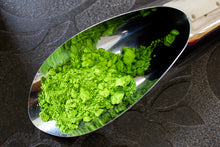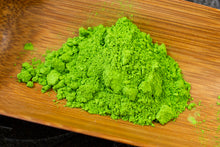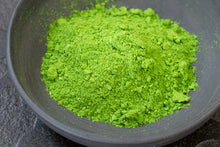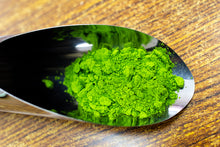
Uji Matcha

This ceremonial grade of matcha comes from the famous Uji of Kyoto, Japan. Each tea leaf is carefully hand-picked from shaded tea garden in spring. It’s processed with traditional method and ground with stone mill into fine powder. Its vivid green color is 100% natural tea substances, reflecting that tea is rich in chlorophyll as a result of shade-grown tea.
This Uji Matcha gives a creamy mouth-feel despite this is a pure tea without any additive of creamer or sugar. It has a thick taste with sweetness lingers on palate after the initial strong punch of vegetal taste; a definite healthy-drink sensation, which can be served with traditional way of whisking the fine powder in a matcha bowl, or, it can be added on other drinks or food like soy milk, yogurt or make into spread.
Uji is located at the southern outskirts of Kyoto City of Japan. Founded on 1st of March, 1951, Uji is located in between the two ancient capitals of Nara and Kyoto. The city sits nearby the Uji River.
Historical Background
During Tang dynasty in China, people prepare tea by roasting and pulverizing the tea, decocting the resulting tea powder in hot water and then adding salt.
During Song dynasty, the method of making powdered tea was by steaming. The tea powder is whipped with hot water in a bowl and served.
In 1191, the method of preparing powdered tea were brought to Japan by Eisai. Since then it became an important item at Zen monasteries.
Production
The key in making matcha is that the tea trees have to be covered by sheets for 3-4 weeks before harvest so that it can produce more theanine and chlorophyll. Theanine is one type of amino acid contributing to umami and sweet taste in green tea.
Hand-picked: In making premium grade matcha powder, the spring tea leaves are hand-picked. The plucking season starts from mid-April to mid-May and only the youngest leaves on the top of tea tree are picked.
Steamed: The tea leaves immediately undergoes steaming process for about 20 seconds to halt the enzymatic reaction so the tea leaves will not be fermented. It will remain its natural green color, flavor and nutrition components inside tea leaves.
Air-dried: The steamed tea leaves is blown with air blower to cool down the tea leaves. The leaves are placed on a flat surface to let it dry properly, and then remove the stems and veins. Now, the crude green tea for matcha is ready, it is known as Tencha.
Grinding: A specially designed granite mill stone is used to grind the Tencha into fine powder. Stone grinding can enhance the nutrients and antioxidants.
Grades
Ceremonial grade : This Uji Matcha is of the premium grade of matcha used in tea ceremonies. The fine matcha powder gives a strong punch of umami and creamy mouth-feel, and its sweetness lingers on palate. Every single tea leaf is hand-picked in spring.
Premium grade: High-quality matcha contains young tea leaves from the top of tea tree and can consume daily. The tea leaves are normally harvested with machine.
Confectionery grade: It's produced from leaves at lower part of tea tree, and the harvesting timing is later in spring, or early summer. Its taste is slightly bitter, not creamy and lacks umami.
Preparation
The matcha powder will be placed on a sieve to break up the lumps. About 2-4g of matcha is placed into a tea bowl called chawan with a bamboo scoop called chashaku. The recommend temperature is 70-80°C. If you prefer an initial bitter taste please use higher temperature at 80°C. With lower temperature, the umami characteristic of Uji Matcha is more intense. For 2-4g of matcha powder, please use 60-80ml of hot water. After add in the hot water, and stir well, please use a bamboo whisk known as chasen to whisk it swiftly to get a layer of fine foam. This will increase the creamy drinking sensation of matcha.
Uji Matcha is very east to prepare. It can be added with other beverages like soy milk or yogurt as a daily serving meal.









